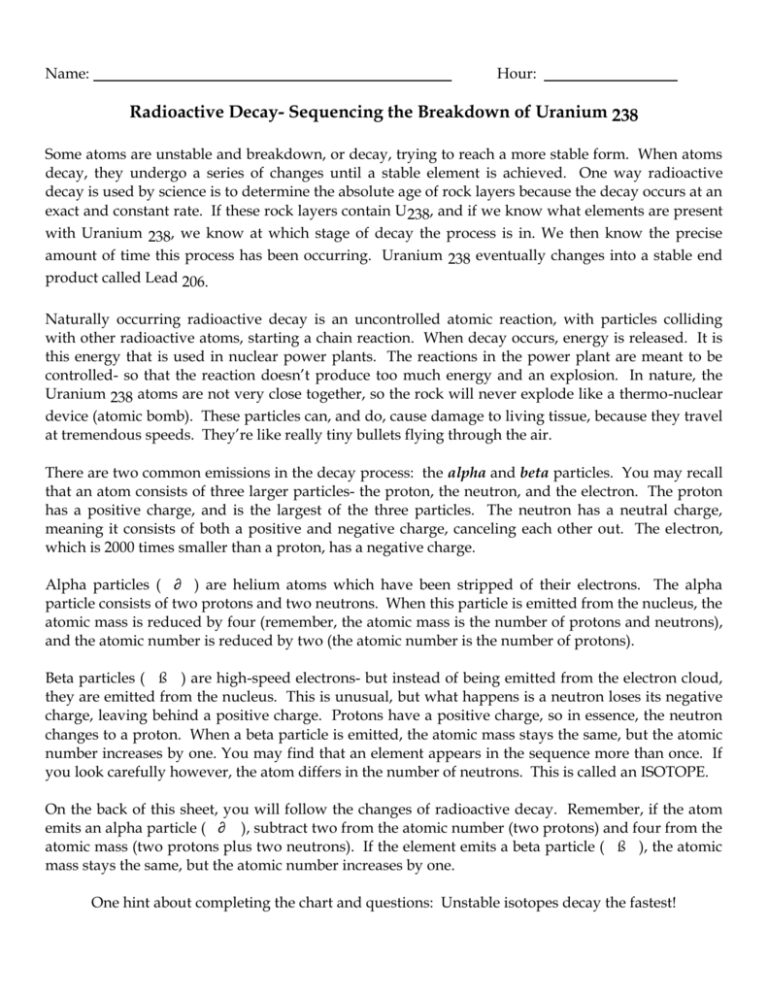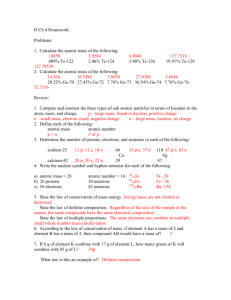U238decay
advertisement

Name: Hour: Radioactive Decay- Sequencing the Breakdown of Uranium 238 Some atoms are unstable and breakdown, or decay, trying to reach a more stable form. When atoms decay, they undergo a series of changes until a stable element is achieved. One way radioactive decay is used by science is to determine the absolute age of rock layers because the decay occurs at an exact and constant rate. If these rock layers contain U 238, and if we know what elements are present with Uranium 238, we know at which stage of decay the process is in. We then know the precise amount of time this process has been occurring. Uranium 238 eventually changes into a stable end product called Lead 206. Naturally occurring radioactive decay is an uncontrolled atomic reaction, with particles colliding with other radioactive atoms, starting a chain reaction. When decay occurs, energy is released. It is this energy that is used in nuclear power plants. The reactions in the power plant are meant to be controlled- so that the reaction doesn’t produce too much energy and an explosion. In nature, the Uranium 238 atoms are not very close together, so the rock will never explode like a thermo-nuclear device (atomic bomb). These particles can, and do, cause damage to living tissue, because they travel at tremendous speeds. They’re like really tiny bullets flying through the air. There are two common emissions in the decay process: the alpha and beta particles. You may recall that an atom consists of three larger particles- the proton, the neutron, and the electron. The proton has a positive charge, and is the largest of the three particles. The neutron has a neutral charge, meaning it consists of both a positive and negative charge, canceling each other out. The electron, which is 2000 times smaller than a proton, has a negative charge. Alpha particles ( ∂ ) are helium atoms which have been stripped of their electrons. The alpha particle consists of two protons and two neutrons. When this particle is emitted from the nucleus, the atomic mass is reduced by four (remember, the atomic mass is the number of protons and neutrons), and the atomic number is reduced by two (the atomic number is the number of protons). Beta particles ( ß ) are high-speed electrons- but instead of being emitted from the electron cloud, they are emitted from the nucleus. This is unusual, but what happens is a neutron loses its negative charge, leaving behind a positive charge. Protons have a positive charge, so in essence, the neutron changes to a proton. When a beta particle is emitted, the atomic mass stays the same, but the atomic number increases by one. You may find that an element appears in the sequence more than once. If you look carefully however, the atom differs in the number of neutrons. This is called an ISOTOPE. On the back of this sheet, you will follow the changes of radioactive decay. Remember, if the atom emits an alpha particle ( ∂ ), subtract two from the atomic number (two protons) and four from the atomic mass (two protons plus two neutrons). If the element emits a beta particle ( ß ), the atomic mass stays the same, but the atomic number increases by one. One hint about completing the chart and questions: Unstable isotopes decay the fastest! Table 1: Radioactive Products of Uranium 238 Decay Element Lead (Pb) Bismuth (Bi) Polonium (Po) Radon (Rn) Radium (Ra) Thorium (Th) Protactinium (Pa) Uranium (U) Atomic # 82 83 84 86 88 90 91 92 Isotope Pb 206 Pb 210 Pb 214 Bi 210 Bi 214 Po 210 Po 214 Po 218 Rn 222 Ra 226 Th 230 Th 234 Pa 234 U 234 U 238 Table 2: ∂ 4.5 x 10 9 yrs ß 24.1 days ∂ 1,600 yrs min ß 2.5 x 10 5 yrs 1.17 min ∂ 3.82 days ∂ ∂ ∂ 8.0 x 10 4 yrs ß 3.05 min ß 26.8 min 19.7 ∂ Questions- Use theßinformation on the first ß page and Table 2... ∂ 1. What is the difference between the three isotopes of Polonium? 1.6 x 10 -4 sec 21 yrs 5.01 days 138.4 days Stable 2. Using your completed Table 2, label the most unstable form of each of the following isotopes: Bi Pb Po Th U 3. Using your completed Table 2, label the most stable form of each of the following isotopes: Bi Pb Po Th U







